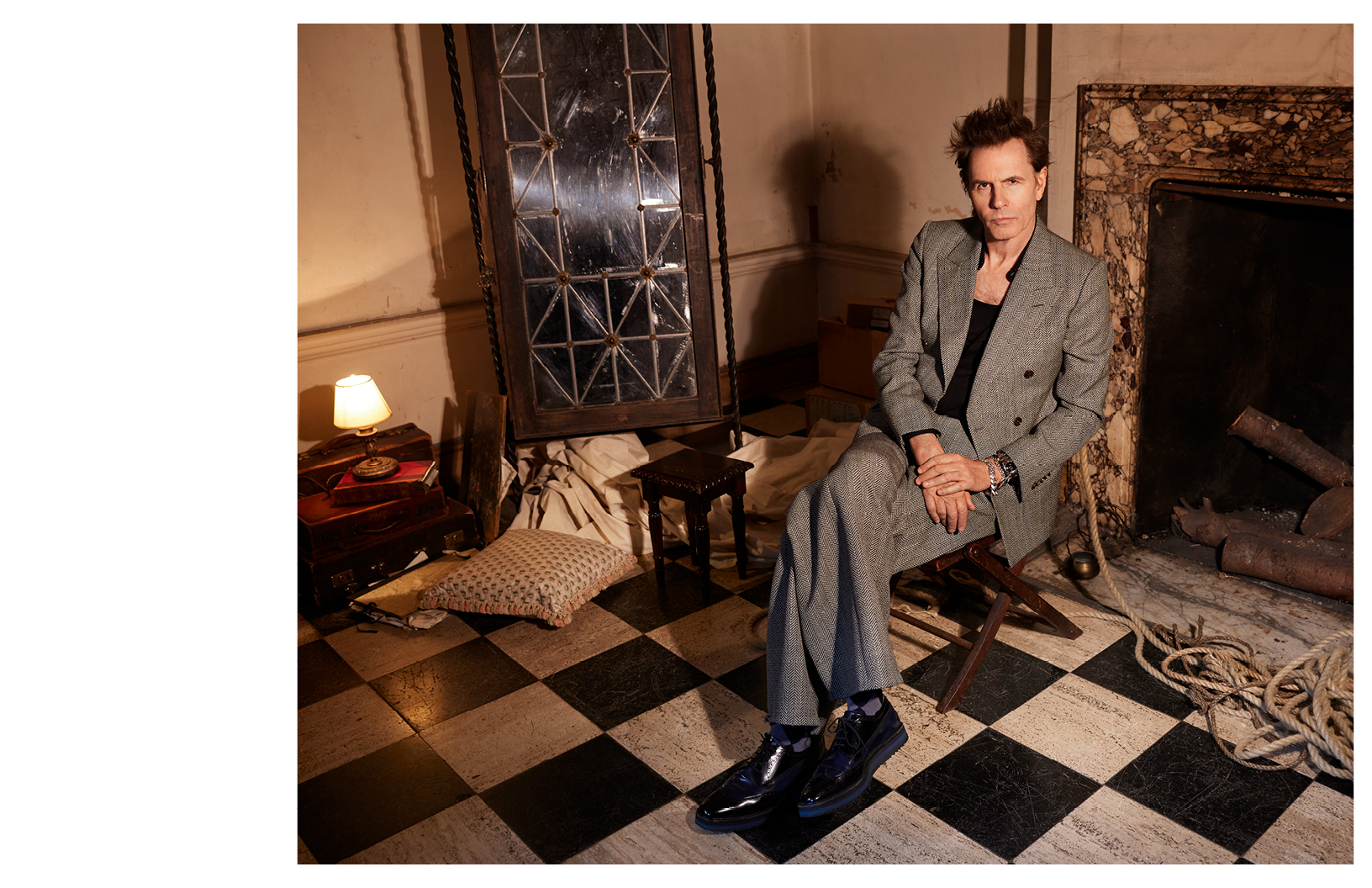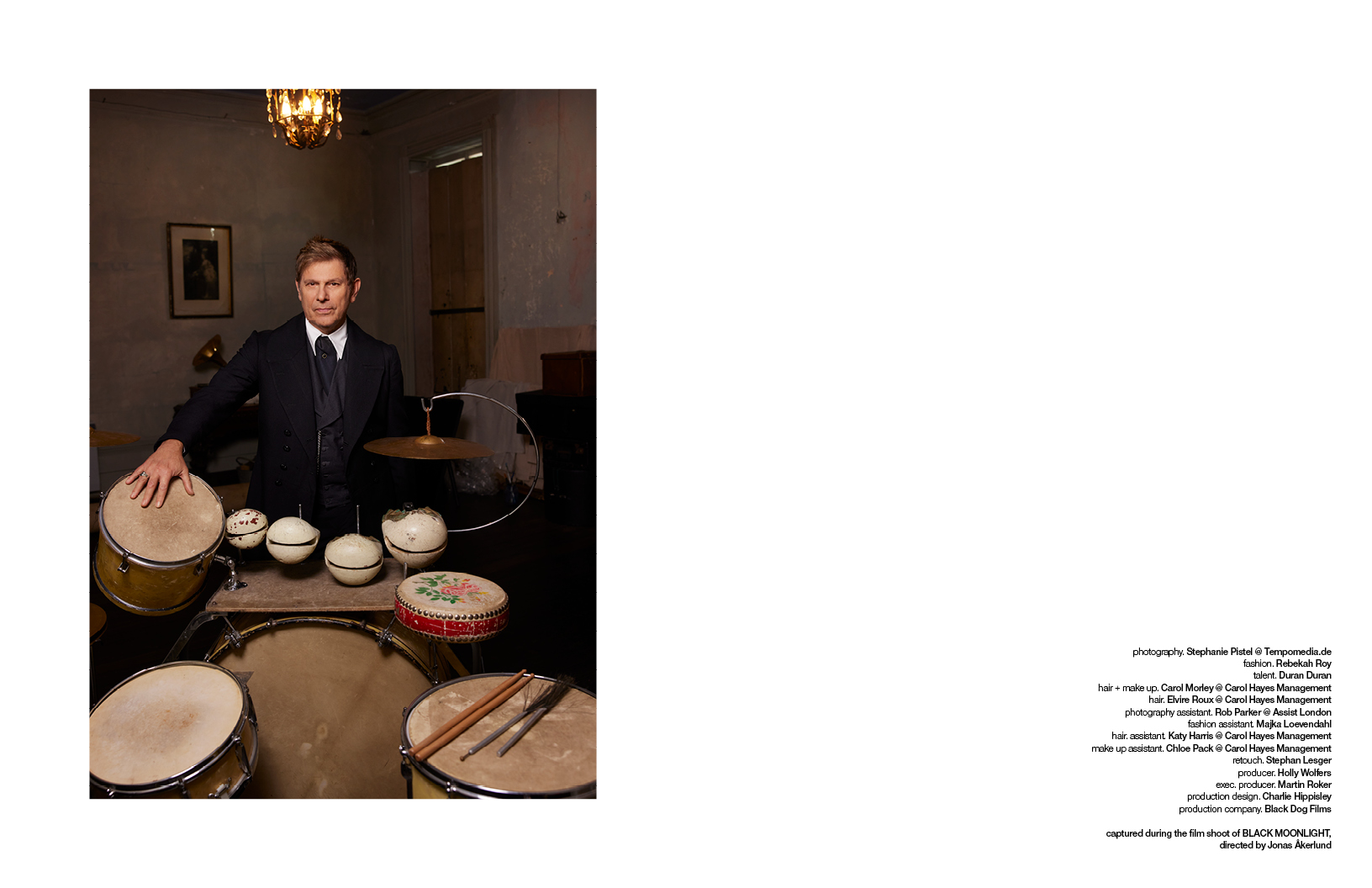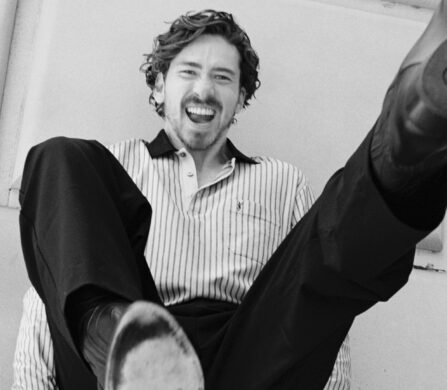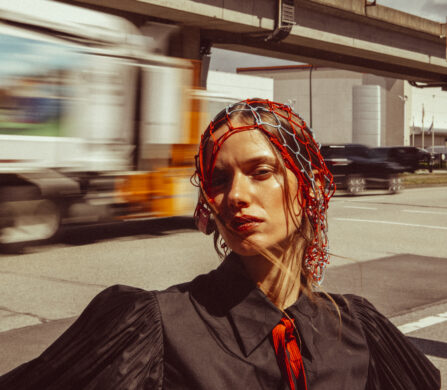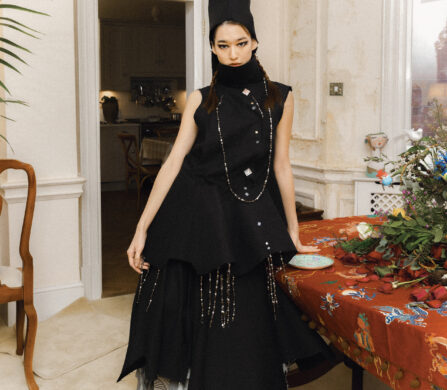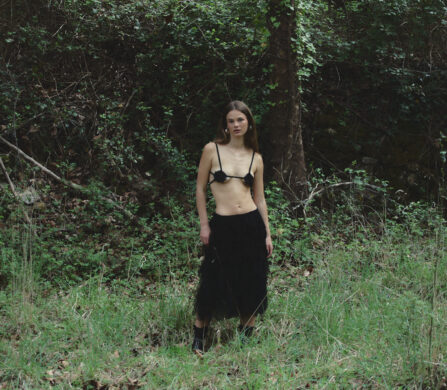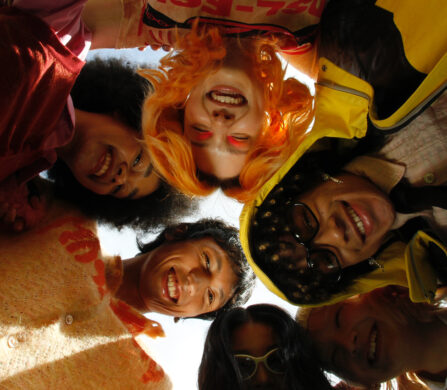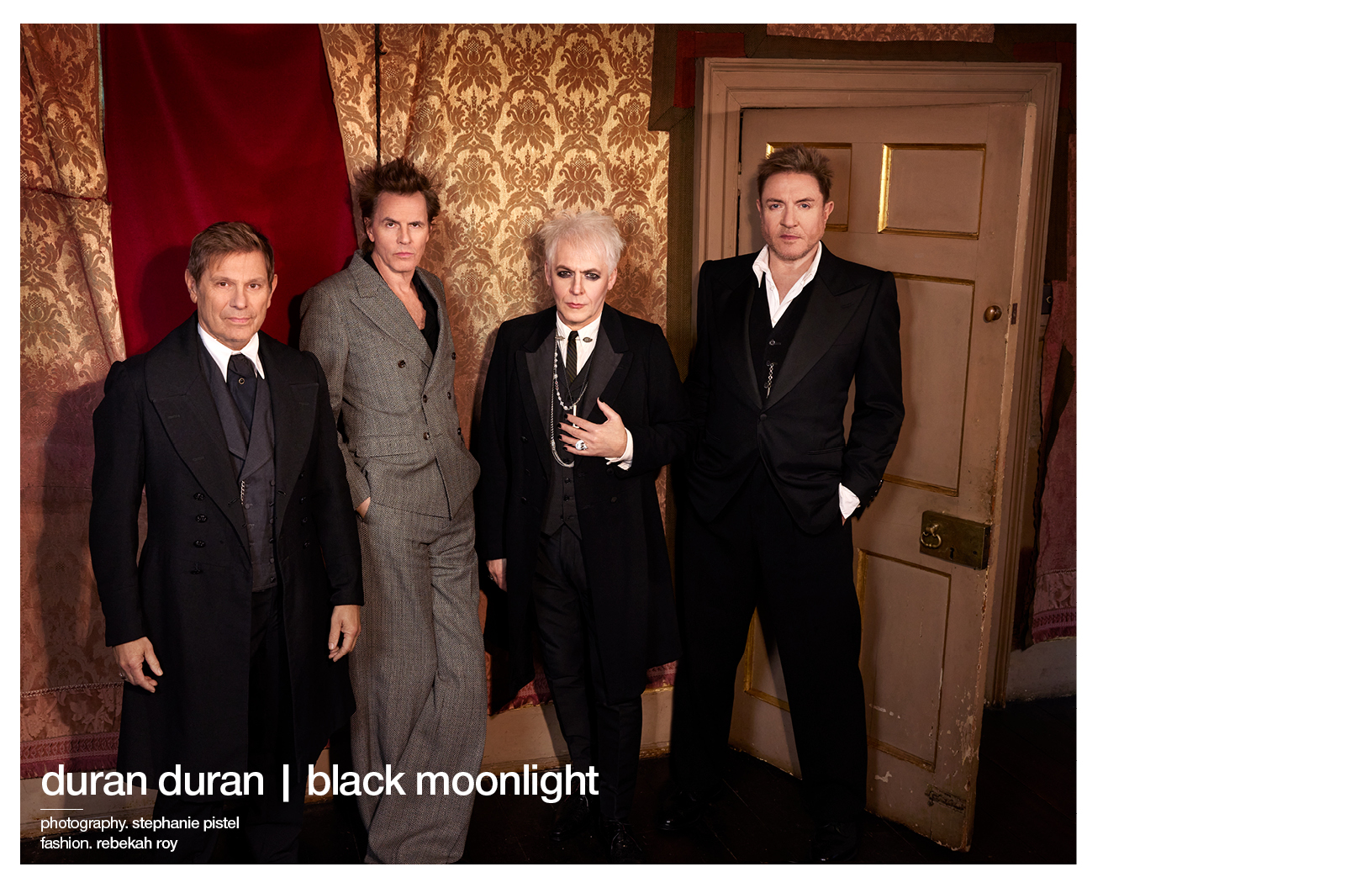
Roger wears
all clothing. Angels Costumes
brooch. Aurum by Guðbjörg
shoes. Prada
John wears
all clothing. Gucci
shoes. Prada
Nick wears
jacket, waist coat + shirt. Angels Costumes
trousers. Alexander Wang
shoes. Jeffrey West
necklaces. Azza Fahmy + Jonas Akerlund
Simon wears
jacket + shirt. Edward Sexton
waist coat + trousers. Angels Costumes
shoes. Church’s
suspenders. Dresime
There are few bands that possess such a stylised and effortlessly cool sound as the new-wave pioneers, Duran Duran. Founders John Taylor (bass) and Nick Rhodes (Keys, production) were two wide-eyed teens in 1978 and struck up a friendship over a mutual love of music, art and film. Once drummer Roger Taylor joined in 1979 and then vocalist Simon Le Bon a year later, the band was finally complete. From there, Duran Duran soon took over the 1980s, receiving wide-spread acclaim thanks to their slick synth-pop tracks. Yes, this time period was a “golden era” for emerging bands to break-out in the UK music scene. However, there has always been something special about the band from Birmingham. Not only did they reach audiences in the UK, they went global, breaking America and other parts of the world. All you have to do is listen to such infectious hits as Girls On Film, Planet Earth, Hungry Like A Wolf, Rio, and The Reflex to get a real understanding of their melodic genius. Combine this with their trend-setting visual aesthetics and the end result was something truly inimitable for its time.
The band was so beloved during the era that they reached certain milestones that some of their peers never could, such as joining the exclusive list of being invited to write and record the theme song for a James Bond flick, 1985’s A View To A Kill. The band was also part of the immortalised line-up for the charity fundraiser gig, Live Aid at the Philadelphia show at John F. Kennedy Stadium. These are just two achievements from an extremely extensive list. Most interestingly, the band not only thrived in the 80s they have also cemented themselves over the last forty-three years thanks to their commitment to never shying away from new ideas. Their discography is now arguably part of the UK’s musical lexicon. They have paved the way for more contemporary bands. From tongue-in-cheek Arctic Monkeys lyrics to being one of the influences for The 1975’s 80s inspired sound on their first two records, Duran Duran has influenced in many different ways.
The last time Schön! caught up with the band for their stellar 2021 record, Future Past. It boasted an experienced band that isn’t stuck on a nostalgia trip, it further proved that the group is taking a modern approach to their art. Now, the band are back for their sixteenth record, Danse Macabre, a spooky and gothic-sounding Halloween concept album which features some new material, reworkings, and surprise covers.
Schön! Spoke with Taylor and Rhodes about the new album, coming up in the 80s, music videos, AI, and what comes next for Duran Duran.
Hi Nick and John, congratulations on the release of Duran Duran’s sixteenth studio album, Danse Macabre. How fun was it to make this record? From the outside, it looks great given its Halloween Halloween-themed with some new tracks, reworkings and interesting cover choices.
John: It was so much fun, actually. The last album that we did was a long haul. You know, it got broken up by COVID I think almost the three years we were working on it. I think by the time we got to the end of that we were all like ‘I’m not sure I’m going to do that again’. We came into this [album] from such a different angle. We did a gig last Halloween in Las Vegas and we decided that we would do it in fancy dress and we would do a whole bunch of cover songs. One night, it took us about half an hour didn’t it Nick with your Halloween playlist, to kind of pull out sort of six or seven songs that we were all excited about doing.
Nick, I like to say how in Duran Duran we do things in an unusual way. We could play the songs live, we went into the studio and we recorded them. When we had them mixed we were like ‘That’s how we’re going to play them live’. Having played them that one time live, we’re then sitting on these recordings that we’re all super excited about. I think I said to you, Nick, ‘Let’s get them out on Spotify and you were like, ‘I think we should make an album’. You then talked about taking some of the older Duran Duran songs and repurposing them. It just grew and sort of became an album, it’s probably the easiest album we’ve ever made, I would say.
Nick: It was definitely the fastest recorded record since the first Duran Duran album. After the amount of time we’ve spent together, I think actually I’m quite proud of that, we all are. I was saying to John last night, we’ve proved it’s possible. Of course, the big difference was that there were only three lyrics to write rather than fourteen because that is often what stalls us and understandably. As that’s much more time-consuming than us finding a great instrumental part and playing it. It was a thrill to do it so quickly, to think we only started to talk about it literally a year ago on Halloween and now the record is out today that, that’s fun.
John: We didn’t have time to second guess anything. We just had to go for it, we do tend to second guess a lot of thoughts and ideas but we knew wanted it out at the absolute latest in time for this Halloween. I think this album is interesting for the fans because you’ve got three sections, there’s the cover songs, there’s the repurposed older Duran songs, and there are three brand-new songs. They were written during this four-day window before our last British tour had started. Essentially we went in to write one song, we had the title Danse Macabre and we said: ’let’s go and see if we can write a song with that as a title’.
I mean, we knew we were going to write a song, we were not going to leave that studio without a song with that title but we came up with three songs. Like Nick said, I think going in there with this umbrella concept, particularly for Simon, I think we all embraced the theme, everybody played something that we felt was in that Gothic, darker realm kind of thing. But for Simon, I think it was a real gift because he had his subject already and that’s usually what takes so long when we’re writing songs from scratch.
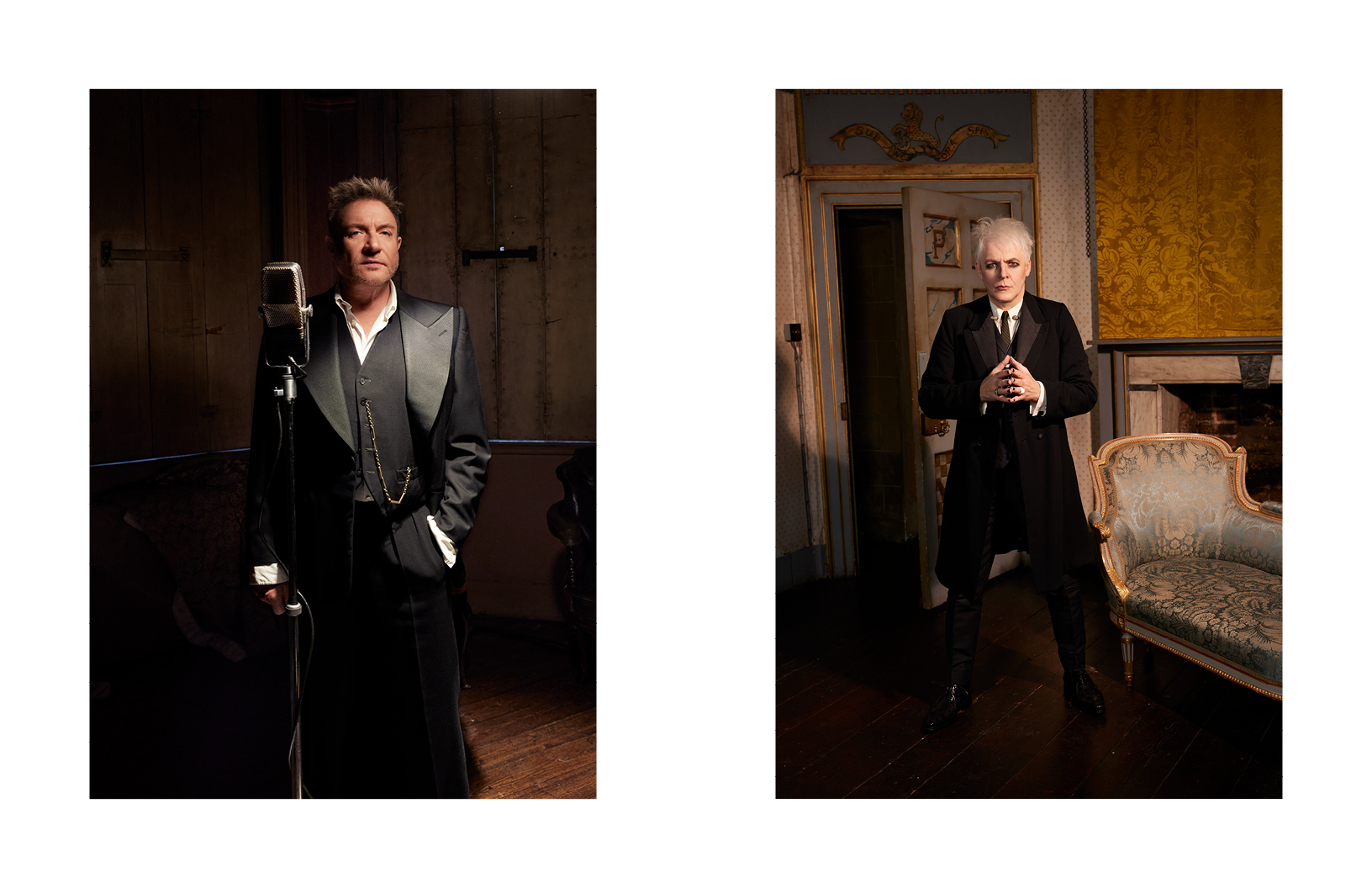
jacket + shirt. Edward Sexton
waist coat + trousers. Angels Costumes
suspenders. Dresime
opposite
jacket, waist coat + shirt. Angels Costumes
trousers. Alexander Wang
shoes. Jeffrey West
necklaces. Azza Fahmy + Jonas Akerlund
Speaking of one of the original songs on the album, how did it feel to team up with long-time collaborator Nile Rodgers again on Black Moonlight? Your relationship goes way back to the 1984 track “The Reflex” and he also produced Duran Duran’s fourth LP, Notorious (1986).
Nick: Well, Nile has never really been far off our radar. We’ve always had a relationship with him and we’ve worked with him at various times. We actually worked with him when we were doing the Astronaut album for the reunion. We worked with him again on the song Pressure Off which was on Paper Gods. This time we worked with him on a couple of songs, one that’s on the album, Black Moonlight, and then we did another song. John said we got three songs, we did get three finished songs for this album but as a bonus, we got a second track with Nile which is not complete yet. But actually, it’s something really special. I think so when Nile comes into the room, he brings in energy unlike anyone else we’ve ever worked with. He’s a machine. He plugs in and it’s as if all the information flows out of his fingers and he’s smiling the whole time, the level of energy in the room goes up through the roof and it is infectious.
You rise to challenge Nile’s level of enthusiasm about things. I think there’s always a joy when we work with Nile too which is something that you can’t quantify. I’ve always said that personally for me, a lot of things about production are about the vibe that people create. It’s about the atmosphere. It’s about the mood in the room, and the excitement or the tension or whatever that might be. But with Nile, he’s the master of all of that. He walks in and the room is his really. We all know each other so well. Nile always says: ‘Oh, my first band is Chic and my second band’s Duran Duran’. He’s been on tour with us for Chic over the last five years really. We have a great time together. It’s a joy doing anything with him.
When you think about the fact that in 1978 you were two eager young teens who decided to form a band and for it to then to blow up and become a lasting group that has had such an impact on the music industry in the 80s and continually throughout the years, how does that make you both feel?
John: Well, we tend about once a month to look at each other and go, ‘we’re not doing doing too badly are we?’ [laughs] You know, we’ll say something simple like that to each other that puts everything in perspective. Yes, we formed a band at a time… I mean, I hate to say it was a golden era for bands, Nick and I joke that we used to play Chartbuster, a board game that was popular in the 70s, ‘throw a six and your single goes to number one’, but we really studied. We were both students at the school of pop music and we really knew we just had an understanding of what it was going to take to get our project into the charts, onto TV, and to stages around the world. Getting the band together and putting everything in place, Nick and I were almost like the kind of impresarios that formed bands like NSYNC in a way. We knew we had this vision and by the time Simon joined, he was the last guy to join. We had already built the architecture of the sound.
We knew we had this sort of disco-punk-techno-hybrid that we felt was new, that nobody else was doing quite like that. Simon walked in, and we were like ‘yes, you’re the guy’. Thirty days later, we did a show and essentially the show had the songs that made the first album. We benefited from the kind of education that kids of our generation had. By watching the music scene, if you like, as teenagers, but also it was a time when record companies were just tripping over themselves trying to find the next big thing, trying to sign bands and putting money behind them. We were lucky enough to be on a multinational label that was able to send us off around the world and give us an extraordinary experience within our first year of having releases.
Nick: It was so radically different then though because what we did really was grassroots. We came up from loving music, and playing music together, and we were all living in the same city, Birmingham. We had a vision that we had to slowly do. We played loads of shows in Birmingham at pubs, bars, small tiny clubs, and venues, and we had to keep playing and keep playing at those places to then get one show in London, one show in Manchester that came up and that’s how you built it. Now when you look at it, kids sitting in their bedrooms with computers, clicking something that goes everywhere online, it’s a double-edged sword. I’m all for it for those who are good at it and there’s some amazing music coming out but at the same time, it must be very hard for younger bands now I think to break out because there’s so much competition. There’s too much information everywhere.
You just had to work at it and have that vision and find the only way you could, play a show in a town, the way that people found out about it was a tiny little advert in the local newspaper or posters on the walls and you had to rely upon the fact that somebody somewhere in that town might walk past that poster, notice it, and say ‘hmm, I might go to that’ then remember it or write the name down on a piece of paper, go and tell a friend, then go and buy tickets and turn up there. You know now we’re also used to ‘oh, let’s go to the website, let’s go to Instagram, let’s look at what’s out there’. It was so different but actually, I’m very grateful for what John, the band, and I experienced when we were growing up and that’s how it happened for us in that organic way. It’s really hard to do that now.
Yes, it is so interesting how the musical landscape has changed since the birth of the internet. Now, you have to get noticed in such a different way, a lot of talented independent musicians are trying to get fifteen seconds of their song to trend on TikTok and then they may get interest or signed by a major label.
John: I was reading a review for an art show called ‘Bohemia and Creativity’ or something like that. It essentially said at the end of it that bohemia is no more, it doesn’t exist anymore because bohemia, required a place where people could gather. We had The Rum Runner, we had we had several clubs in Birmingham, where we could go and we could meet people that dressed the same, not the same but had the same approach to to dressing and doing hair and the kind of music that we listened to. Those were the big three things that you would bond with people over and that sense of place doesn’t exist anymore.
It’s a much more nebulous global thing which exists on the internet, but it doesn’t have that same… you know, neither Nick nor I wants to sort of say: ‘oh, it’s not like it used to be’ Obviously today is full of opportunity and full of extraordinary things. But there is something to be said, we were lucky that we found ourselves in a place where we were able to really grow. To Nick’s point about putting music out now, you write something in your bedroom, you put it out on Spotify that afternoon, I’m also grateful that we went through the curation process where we met people, executive producers, all sorts of people that came in and gave us their take on where we were at and helped us shape what it was that we were doing.
Nick: It’s interesting being able to see your audience too because every time we played a show we could see our audience, we could see the kind of people that we were attracting. The kind of people that were relating to what we do. Again, now I would find that quite difficult because even with Instagram and everything else, you don’t know half the time whether it’s AI or whether it’s someone just testing something. It’s a strange landscape, it’s amazing and really there are some incredible things out there, but it’s just so different.
Just to break things up, I have two individual questions. Nick, I would love to hear more about your desire to get into filmmaking. The documentary you’re making on postwar Japanese photography must be so absorbing.
Nick: Look, I’ve been talking about making films since I was about sixteen, the same time we got into the band. I thought: ‘Oh, I’ll do this for as long as it lasts then I’ll make some films’. We all have different desires to do different things, writing books, art shows, I do a lot of photography. John and I did an art show together in Ibiza, I did one and John did one and that was a lot of fun. We met and bonded in the first place over music, art and film and so things do happen. The one thing that I’ve been working on sort of on and off, more off for the last five years, but now I’m hoping to be a bit more on, is a documentary on post-war Japanese photography, which I really want to do because I love a lot of those Japanese photographers. I think they are somewhat unknown in the wider world out there.
So I would love to just introduce them to people and show how far ahead Japan was at certain times. We’ve got all these photographers that we all love who are amazing such as Richard Newton, Helmut Newton, and Irving Penn. But the Japanese have their equivalents to these photographers and they are extraordinary. So I was lucky enough to meet a lot of them, and interview them, and I’ve just got to edit it all. The problem is it’s all in Japanese.
John: There must be some sort of AI…
Nick: I have no idea, I need a dual-speaking editor to work with on it, which I’m going to find.
We all love visuals [in this band] and putting things out there, we’re not afraid to do different projects with people. It’s exciting sometimes to do something a bit different for a while because we are like a strange little arts lab. There are lots of different things we can do together whether it’s making a video, film, TV series or putting together a show. We never really limit ourselves. Of course, the core of everything we ever do is the songs and then being able to play them and present them live but aside from that we’re open to lots of things.
John, I’m curious, you’ve taken up Tai Chi to help with recovering from shows. Please would you tell me a bit about that?
John: Well, that [Tai Chi] was a response to what I was experiencing physically from the touring that we’ve been doing this last couple of years. Physically it was never a problem for me playing live, these last couple of years, I think, first of all, we really upped our game. It’s a very physical show that we have, it’s a lot of music, and we’re playing on a really high level. I’ve been getting back from some of these touring gigs and just feeling terrible and at one point, I thought, I’m going to need a hip replacement, I’m at that age [laughs]. I’m allergic to surgical procedures. I’ve never spent a night in hospital and I want to keep it that way. I was introduced to the idea of Tai Chi, interestingly, Lou Reed has posthumously put out a book about his Tai Chi practice.
I’m just trying to make it something that I can rely on but I’ve been through a lot of fad fitness routines. I mean, we’re not really athletes in this band but you are called upon to do something that is quite athletic in a way. You just have to learn these new strategies for functioning and thriving as well. I’m just open, I’m not doing Tai Chi today, I’m doing Pilates today. That’s also pretty good, anything to avoid real hard work, I hate gyms.
When Duran Duran was dominating the 80s, you were one of the first bands to really ride the MTV wave when it comes to music videos. In 2023 do you think the music video is dead now given it’s not quite as much of a spectacle as it used to be?
Nick: We were there before MTV, so I think they saw our early videos, and I would hazard a guess that along with many other artists who were also starting to make videos, that was what gave them the idea, that times were changing and the young new artists were starting to make visual clips to go with their music. Instead of it just being audio on radio they thought to take it onto TV, and people are going to love it. When I first heard the idea, I thought why didn’t somebody think of that? Twelve months ago, eighteen months ago, when we were making our very first videos. It seems so obvious and it was embraced by everybody. We were very lucky with our timing. It was fortuitous because we were really learning how to make those videos and we did a pretty good job with them at that time. We were surrounded by great people, people like Russell Mulcahy, Godley & Creme who were at the top of their game as video makers. We were providing the content that MTV wanted, and they were providing the promotion that we wanted.
I think videos now are still important, and in a way, there’s been a bit of a renaissance because you’ve got lots of different tools to make videos with now. Ironically, at the beginning, our first video was made on video, for the track Planet Earth. We couldn’t afford film, so we quickly moved towards 35-millimetre film, because it looked so great. Now, as most major movies are made on digital video, it is much easier to make rock videos and dance videos on video. It’s cheap, and it’s quick. Of course, the great ones still cost a lot of money because you need a good idea, a good director, and whatever the special effects are. All of those things. We’ve been making videos for a long time and it’s about the ideas still. When we made a video on Future Past for the song, Anniversary, we did it with a lady called Alison Jackson. It was a complete spoof with lots of look-alikes in it, including look-alikes for the band. It was a really unusual thing to do.
The video we’ve just made that will be coming out sometime over the next couple of weeks for a song on this new album, we made with Jonas Åkerlund, who is again the grandmaster of videos. He did the Girl Panic! video with us many years ago. We’ve just done something… I’m not going to give it away too much but I think it will be one of the most unusual videos that we’ve ever made. I think it does still have value, of course, the focus isn’t there because everybody was looking at MTV. Now, everybody’s mostly online, I guess YouTube is really the focus for videos now.
There are some classic cover choices on the record such as The Talking Heads, The Rolling Stones, Siouxsie & the Banshees. Who suggested Billie Eilish’s brilliant song, Bury A Friend? It’s more of a contemporary track thrown in and it’s great.
John: Yeah, we were talking…
Nick: I said to the group, I think we should do something much more contemporary, maybe something from the last five years rather than songs from thirty or forty years ago. With Billie Eilish’s track, we love that song. We talked about it and convinced each other we could find a way to do this. We then had to convince Simon but interestingly he didn’t resist it that much did he? He got his head around it. I think we all think about what the band’s vocals are going to be how and how we’re going to make that work.
John: We went away and prepared something that we thought was a really good direction. I think he just liked what we did. Strangely, this album was done almost all remotely. We all worked independently of each other. It’s the first time that I think we’ve done that. I was working in Los Angeles, I would build some of the tracks, or Nick would build something and send it to me. When we kind of felt it was in a good place, then Simon would come in, and he would work and we had no idea how he was going to approach it. We would then get a mix the next day and we would react like: ‘wow, okay, so he went down that road’, it was quite interesting. I think, we were able to work like that because we had been on the road so much last year.
Anybody in a band will tell you the best time to go into the studio is when you’ve been on the road, and everybody’s so tight, but of course, it’s the last time anybody really wants to go into the studio because we are all knackered and we’re all sick of the sight of each other. But essentially, that is the best time to record. We were very focused and even though we weren’t in the same room, I feel we were thinking as one and our thoughts just connected really well. I think we could have all been in the same city or been in the same room and actually, it would not have been as cohesive as as how it turned out.
Nick: Yeah, one of the other great things to that point is that we used our backing singers from the tour. Anna Ross has been with us for a very long time, and Rachel O’Connor has been with us for a couple of years now. They sound so great together, and they have become part of our sound in the live show. It made perfect sense to use them on the album. I think Simon did an amazing job actually with the vocal arrangements with them. That’s one of the things that gives the album its sound and makes it more cohesive. Everything sounds like a band playing it, and it’s the same band. Of course, the guitarist varies over the tracks, Andy Taylor is on about eight of them, Warren Cuccurullo is on a couple, Dominic Brown is on a couple, and Nile is on it.
Yeah, everything from the sonics to the visuals seems so cohesive on Danse Macabre. The album’s artwork is stunning too, a genuine photo taken from a collection of vintage seance photos.
Nick: I mean, that was a very simple thing. A friend had tipped me off and said: ‘Oh, this looks like something you would like’ not knowing that we were doing a Halloween album. I looked at it and thought, well actually that’s kind of incredible. They were photos that are undeveloped here from the 1940s, plus these glass plates that had amazing images, one of which is on the front cover. They were at an auction, I managed to acquire them and then took them to Rory McCartney our graphic designer. He looked at me as if I’d given him a bag of gold and just said ‘wow, these are amazing’. They’re authentic, so crazy that they were doing these things, these elaborate setups to just literally try to trick people into believing that these ghosts were visiting and there’s ectoplasm in the room. They are crazy but amazing too. It was a real gift, timing is everything.
As a band that has never shied away from trying new things, even being one of the first to welcome new ideas like using AI to create work like Danse Macabre’s music video, will you continue to use experimental ideas to elevate your work?
John: I don’t think it’s so much about elevating, I mean, I think you want the absolute most that you can get out from the band members at any given time. It’s funny, I was thinking about this earlier today, I was thinking about how you know everything begins in the studio with us. Everything begins with a spark of an idea and a song. if we attend it properly, a song grows from it, and the song becomes part of an album, part of a project, there are visuals, there are videos, album covers, then we take it to the stage and so on. The further out that it radiates from that initial idea, I think there are all sorts of things you can bring in to help expand the song’s reach if you like.
Therefore we used AI for the video for Danse Macabre. There are many things that you can do but I think at the core; I was thinking earlier today well imagine if I didn’t want to show up to a writing session at one time in the future or even if I was unable to, I could send a version of myself that would just feed back John Taylor baselines into the room. My point is that I would certainly never choose to do that because that creative thing that we have is what makes life worth living in a way.
I don’t want to turn that over to somebody else but these tools are available. They allow you to extend your life. It’s like hip replacements, art surgeries and all sorts of things. Technology allows us to expand ourselves, our lives, and the possibilities of what we can do, so we embrace it.
Nick: I agree One final thing about AI is that there’s a lot of controversy about it. I actually think it depends what you want it to do. I agree with John, AI does not replace people, it needs people to programme it and tell it what to do. You either use AI to your advantage you use it as a tool, which is precisely what we did when we made the video. But you don’t try and replace anything. That’s how I see it being used artistically. But there are really great things that can happen with it such as the medical side for sure. There are also really terrible things that could happen If it gets into the wrong hands.
A lot of people have talked about it, what happens if it gets weaponized and starts making bad things is quite terrifying. It’s down to us as human beings to have the right judgement and to not let it be used in the wrong ways, used in the right ways it could make the world an amazing place. A more futuristic place than it is in good ways but using it the wrong way will lead to a catastrophe.
John: Yeah, It’s a little bit like auto-tune getting into the hands of the wrong people.
Finally, what’s next for Duran Duran?
Nick: We have some shows for next year. We’re going to meet up in the next couple of weeks and listen to some material, some unfinished business. Things that we have from the past that we feel should be cleaned up a bit and things that we may want to put out such as the album Reportage, we keep getting asked about it.
It’s the last album we made with Andy in 2006. It was almost finished and actually, from what I remember, it’s pretty decent. We’re going to have a look at that and see if we want to put that out. We’ll see.
Duran Duran’s sixteenth album Danse Macabre is out now.
photography. Stephanie Pistel @ Tempomedia
fashion. Rebekah Roy
talent. Duran Duran
hair + make up. Carol Morley @ Carol Hayes Management
hair. Elvire Roux @ Carol Hayes Management
photography assistant. Rob Parker @ Assist London
fashion assistant. Majka Loevendahl
hair. assistant. Katy Harris @ Carol Hayes Management
make up assistant. Chloe Pack @ Carol Hayes Management
retouch. Stephan Lesger
producer. Holly Wolfers
exec. producer. Martin Roker
production design. Charlie Hippisley
production company. Black Dog Films
interview. Cameron Poole
captured during the film shoot of BLACK MOONLIGHT,
directed by Jonas Åkerlund














